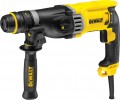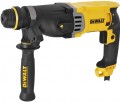Real power
The power given out by the perforator directly to the drill or other working equipment. This figure is inevitably lower than the power consumption (see below) due to energy losses in the tool mechanisms.
In general, higher net power means more efficiency and productivity; the reverse side of these advantages is an increase in price, energy consumption, dimensions and weight (however, the latter is not always a drawback for rotary hammers). In addition, note that tools with similar useful power values may differ in the ratio of chiseling speed and impact power: remember, a higher frequency means less energy for each individual impact, and vice versa. So the big numbers in this paragraph can mean both high efficiency when working with hard, stubborn materials, and good performance on relatively simple tasks; these features need to be specified separately.
Also, by the ratio of useful and consumed power, one can evaluate the efficiency of the tool in terms of energy consumption: the lower the power consumption (with the same useful power), the more efficient this model is. The downside of energy efficiency is often increased cost, but it can be recouped fairly quickly in energy savings, especially if you work long hours and often.
Chuck type
The type of cartridge used in a rotary hammer to hold a working tool.
—
SD+. Abbreviation for it. "Steck-Dreh-Sitzt" — "insert-turn-fixed." Today's most common rotary hammer chuck, used in low and medium power models. It has a 10mm diameter shank with 4 slots and accepts tools from 4 to 26mm in diameter and 110mm to 1000mm in length. The advantages of SDS + are the reliability of fastening and convenience when changing tools — it does not require additional devices such as keys. The main drawback is the significant beating of the tool during rotation, due to which such a cartridge is very poorly suitable for drilling.
—
SDS Max. Modification of the SDS + cartridge (see above), intended for use in powerful professional models. It has a shank diameter of 18 mm and allows the use of tools with a diameter of up to 55 mm; otherwise similar to SDS+.
—
SDS-Quick. A variation of the SDS cartridge (see above), in the shank under which protrusions are used instead of grooves. It is also possible to install tools with 1/4" hex shanks in such a chuck. The most common tool diameter for SDS-Quick is 4-10 mm. This chuck is used relatively rarely.
—
Quick release. Chuck for holding drills and other tools used in drilling holes. The design is similar to those used in electric drills — it has 3 cams, it is designed for a too
...l with a cylindrical shank without grooves, and hand force is enough to install / remove the tool. Such a cartridge is devoid of the main drawback of SDS — beats during rotation; this allows you to use the rotary hammer for drilling with good quality. On the other hand, it is much worse for chiselling than SDS. Therefore, keyless chucks are usually supplied as an accessory and are installed instead of the standard SDS chuck.
— Key. The presence of a special key cartridge in the delivery set of the rotary hammer, usually in addition to the standard SDS (see above). In terms of mounting design, this chuck is similar to the keyless chuck (see above) and is also designed for use in drilling. Its main difference lies in the method of installing / removing the tool: you can’t do this with your bare hands, you must use a special key to compress / unclench the cams. Such a system is somewhat more reliable than a quick-clamping system, but much less convenient: changing a tool takes a lot of time, and the key can be lost.Quick chuck change
Possibility of
quick replacement of the perforator chuck — usually from a regular SDS to a quick-clamping one (for more details, see "Chuck type"). Such replacement is carried out in a few seconds and does not require additional tools.
Functions
—
Soft start. A function that provides a smooth spin-up of the tool motor, with relatively little acceleration. This is achieved by limiting the starting current. Without such a limit, the current drawn by the motor at the time of starting can be quite high, causing the motor to start very abruptly, which increases the risk of letting go of the tool. In addition, current surges can lead to overloads in the network used for power. Soft start allows you to eliminate these phenomena to some extent. Note that it only applies to mains powered models.
—
Speed controller. Electronic limiter for the maximum speed of the tool attachment. This is implemented using a rotary switch on the tool body, turning it clockwise increases the maximum allowable speed, against — reduces it, which allows you to take into account the characteristics of the materials that need to be drilled or gouged.
—
Maintain momentum. The presence of an electronic adjustment system that automatically adjusts the rotation speed depending on the diameter of the working tool and the type of material. At the same time, the regulator maintains a constant speed regardless of the load — by changing the power supplied to the tool. Automatic adjustment increases the quality of processing and productivity, and also increases the life of both the working tool and the hammer itself, ensuring optimal operati
...on.
— Soft blow(economy mode). A special mode of operation in which the impact energy and rotational speed provided by the rotary hammer are reduced. This affects two things: firstly, the tool acts less intensively on the material being processed, and secondly, wear and energy consumption are reduced. The first feature will be relevant when processing fragile materials that can be damaged by too powerful chiselling; the second — when working with soft materials, which lend themselves well to even not very strong impact.
— Anti-vibration system. The system for suppressing vibrations transmitted from the operating unit to the operator. Strong vibrations impair the accuracy of work, and also lead to rapid fatigue; vibration protection reduces these effects. It is used mainly in expensive professional models designed for long-term operation.
— Safety clutch. Mechanical safety system that protects the hammer from breakage, and the operator from injury in case of jamming of the working tool in the material. When this happens in the drilling mode, the engine experiences critical loads that can very quickly disable it, and when chiseling, the hammer itself also starts to move, transmitting vibration to the operator’s hands. The safety clutch is set to a certain load level; when it is exceeded, it is destroyed, breaking the connection between the working tool and the perforator mechanisms.
— Power button lock. The ability to block the power button in the off and/or on state. In the first case, the lock provides protection against accidental pressing, and can also play the role of child protection — the lock button is usually quite tight, and a curious little child will not be able to press it. The second option is useful if you need to work for a long time without a break, and it is inconvenient to keep the power button pressed all the time.
— Brushless motor. The presence of a brushless (brushless) motor in an electric tool. Such motors are noticeably superior to traditional collector motors in terms of efficiency, which can significantly reduce energy consumption without sacrificing power; this is especially important for cordless tools (see "Power Source"), where this feature is predominantly found. In addition, brushless motors are quieter and produce virtually no sparks during operation, making them perfect for working in high fire hazard environments. Their main disadvantages are traditional — the complexity of the design and high price.
— Backlight. The perforator has its own lamp that illuminates the work area. This feature is useful if there is little natural light, and there is no way to install artificial light — for example, when working in cramped conditions.
— Reverse. The reverse function allows you to rotate the working tool of the rotary hammer in the opposite direction. This can be useful, for example, to release a drill stuck in the material.
— Synchronization with a smartphone. The ability to connect the instrument to a smartphone or other gadget (such as a tablet) via Wi-Fi or Bluetooth. Such a connection is usually used to adjust operating parameters such as speed or torque; doing this through a mobile application is often more convenient than through the controls on the instrument itself. And some models with this function also allow you to set password access: the tool simply will not respond to the start button until the correct password is entered on the control gadget.
— Built-in spirit level. Built-in device to control the angle at which the tool is located to the horizon. As in ordinary levels, the role of the scale in such devices is played by a sealed flask with marks applied to it, containing a brightly coloured liquid and an air spirit. By the position of this spirit relative to the marks, the position of the entire tool is determined — namely, its correspondence to the vertical, horizontal, or pre-set tilt angle (the latter option, however, is almost never found in the built-in levels). At the same time, purely hand tools usually provide a single-axis level that reacts only to deviation from the horizontal forward or backward, and models with the ability to mount on a rack (see below) can also have a circular level that controls compliance with the vertical and determines deviations from it in any direction.
— Carbon brush replacement indicator. The presence of a special indicator in the design of the perforator, signaling the need to replace the carbon brushes. Carbon brushes are located in the electric motor and are the most worn part of it, because. subject to constant friction during operation. When the brushes are worn beyond a critical level, the engine power drops, it starts to work intermittently, which can lead to unpleasant consequences up to tool breakage or even injury. And replacing the worn brushes themselves is much cheaper than changing the entire electric motor or even the entire tool.
